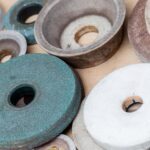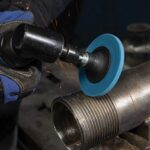
When it comes to achieving precise and high-quality finishes in various projects, understanding grit size in abrasives is crucial. Whether you’re a professional craftsman, a DIY enthusiast, or involved in home renovations, the right abrasive grit guide can make all the difference. At M/s Sandpaper Rodiez, we specialize in customizing abrasives to meet your specific needs, offering high-quality sandpaper imported globally and tailored for your unique requirements. In this comprehensive guide, we will delve into the significance of grit size in abrasives, how to choose the right grit size, and its impact on your projects.
1. Introduction to Grit Size in Abrasives
Abrasives are materials designed to remove or smooth the surface of other materials by applying friction.They play a vital role in various industries, including woodworking, metalworking, automotive, and construction. Grit size refers to the size of the abrasive particles embedded in sandpaper, grinding wheels, and other abrasive tools. It directly affects the performance and outcome of your sanding or grinding tasks.
1.1 Why Grit Size Matters
Selecting the appropriate grit size is essential for achieving the desired finish on your project. Using the wrong grit size can lead to suboptimal results, increased labor, and potential damage to the material. This guide will help you understand how different grit sizes affect abrasives and how to make the best choice for your specific needs.
2. Understanding Grit Size
2.1 What is Grit Size?
Grit size is a measure of the abrasive particle’s coarseness or fineness. It is usually indicated by a number on the abrasive product. The higher the number, the finer the grit. Conversely, a lower number denotes a coarser grit. Grit size impacts the abrasiveness of the material and how it interacts with the surface being worked on.
2.2 How Grit Size Affects Abrasives
- Coarse Grit (40-60): Coarse grits are designed for heavy material removal and rough shaping. They are ideal for initial sanding or grinding tasks, such as removing old finishes or shaping rough surfaces.
- Medium Grit (80-120): Medium grits are used for intermediate sanding and smoothing. They help remove scratches left by coarse grits and prepare the surface for finer grits. This step is essential for refining the surface and ensuring an even texture.
- Fine Grit (150-220 and above): Fine grits are used for final finishing and polishing. They are essential for creating a smooth surface before applying paints, stains, or other finishes. Fine grits help in achieving a high-quality, professional finish.
3. Choosing the Right Grit Size
Selecting the appropriate grit size is essential for optimizing the performance of abrasives and achieving the best results. Here’s a guide to help you choose the right grit size based on your project requirements:
3.1 Determine the Material
Different materials require different grit sizes:
- Wood: For woodworking, start with coarse grit for heavy material removal. Progress to medium grit for smoothing, and finish with fine grit for a polished surface.
- Metal: In metalworking, use coarse grits for initial grinding and rust removal. Medium and fine grits are used for smoothing and finishing metal surfaces.
- Plastic and Glass: These materials often require finer grits for a smooth finish. Begin with a medium grit and move to fine grit for the best results.
3.2 Consider the Task
Your task will influence the grit size you need:
- Heavy Material Removal: Use coarse grits to quickly remove large amounts of material or to shape rough surfaces.
- Surface Smoothing: For smoothing out surfaces and removing scratches, medium grits are appropriate.
- Final Finishing: For achieving a smooth, polished finish, use fine grits. This is especially important for preparing surfaces before painting or staining.
3.3 Follow a Progressive Approach
For most projects, a progressive approach yields the best results. Start with a coarser grit to handle major material removal and then move through medium and fine grits to achieve a smooth, polished finish. This method ensures that each stage of sanding or grinding prepares the surface for the next, resulting in a high-quality final product.
4. Common Applications of Different Grit Sizes
Understanding how to apply various grit sizes can enhance your results in different applications:
4.1 Woodworking
- Coarse Grit (40-60): Ideal for removing old finishes, leveling rough wood, or shaping new pieces.
- Medium Grit (80-120): Used to smooth out the surface and remove scratches from coarse grits.
- Fine Grit (150-220 and above): For final sanding before applying stains, paints, or finishes.
4.2 Metalworking
- Coarse Grit (40-60): Effective for initial grinding, deburring, and removing rust or welds.
- Medium Grit (80-120): Used for refining the surface and removing the scratches left by coarser grits.
- Fine Grit (150-220 and above): For polishing and achieving a smooth finish on metal surfaces.
4.3 Automotive
- Coarse Grit (40-60): Used for sanding down body filler and removing old paint.
- Medium Grit (80-120): For leveling and smoothing the surface before painting.
- Fine Grit (150-220 and above): Essential for final sanding and achieving a smooth, glossy finish before applying the final coat.
4.4 Construction and Drywall
- Coarse Grit (40-60): Suitable for initial sanding of drywall joints and plaster.
- Medium Grit (80-120): For smoothing out seams and removing rough spots.
- Fine Grit (150-220 and above): Used for the final pass to ensure a smooth surface before painting.
5. Tips for Using Abrasives Effectively
To get the most out of your abrasives and achieve the best results, consider the following tips:
5.1 Select the Right Backing Material
Different backing materials, such as paper, cloth, or sponge, provide varying levels of flexibility and durability. Choose the backing material that best suits your project needs.
5.2 Maintain Consistent Pressure
Apply even pressure when sanding or grinding to avoid uneven surfaces and ensure a consistent finish.
5.3 Keep Abrasives Clean
Dust and debris can clog abrasives, reducing their effectiveness. Regularly clean or replace abrasives to maintain optimal performance.
5.4 Use the Correct Technique
Follow proper sanding or grinding techniques for your material and task to achieve the best results and prolong the life of your abrasives.
6. Conclusion
Understanding grit size in abrasives is essential for achieving high-quality results in various projects. At M/s Sandpaper Rodiez, we are committed to providing customized abrasives that meet your specific needs. Whether you’re working on woodworking, metalworking, automotive repairs, or construction, selecting the right grit size can significantly impact the quality of your work.
For more information about our customized abrasive grit guide and how we can assist you in choosing the perfect grit size, visit Sandpaper Rodiez or contact us at our office located at Plot No 93, Main Chowk, Samaypur, Delhi – 110042. Let us help you achieve the best results for your next project.


